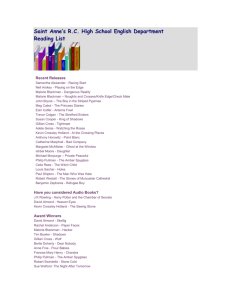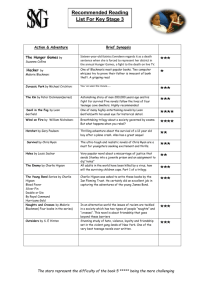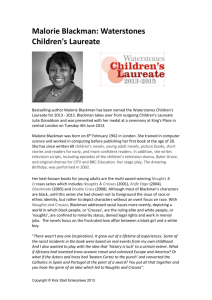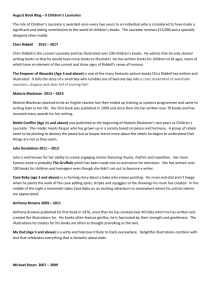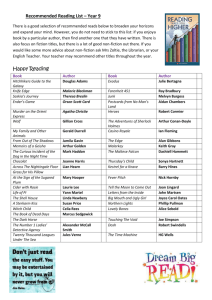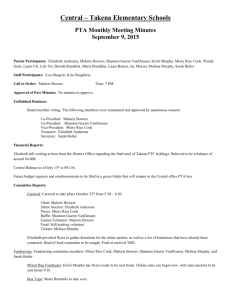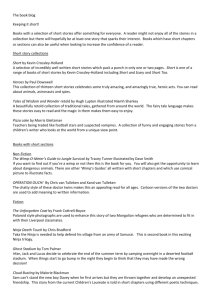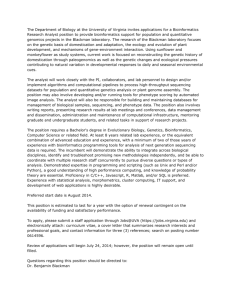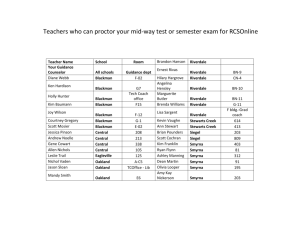Biography: Verna Wilkins, MALORIE BLACKMAN, AUTHOR
advertisement
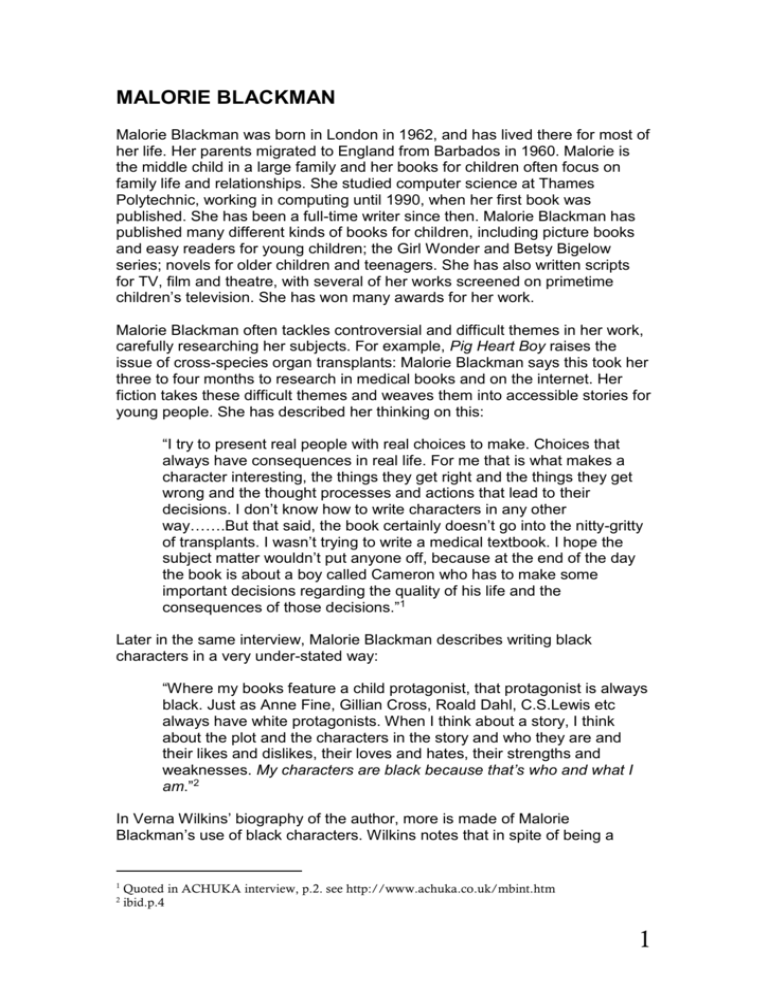
MALORIE BLACKMAN Malorie Blackman was born in London in 1962, and has lived there for most of her life. Her parents migrated to England from Barbados in 1960. Malorie is the middle child in a large family and her books for children often focus on family life and relationships. She studied computer science at Thames Polytechnic, working in computing until 1990, when her first book was published. She has been a full-time writer since then. Malorie Blackman has published many different kinds of books for children, including picture books and easy readers for young children; the Girl Wonder and Betsy Bigelow series; novels for older children and teenagers. She has also written scripts for TV, film and theatre, with several of her works screened on primetime children’s television. She has won many awards for her work. Malorie Blackman often tackles controversial and difficult themes in her work, carefully researching her subjects. For example, Pig Heart Boy raises the issue of cross-species organ transplants: Malorie Blackman says this took her three to four months to research in medical books and on the internet. Her fiction takes these difficult themes and weaves them into accessible stories for young people. She has described her thinking on this: “I try to present real people with real choices to make. Choices that always have consequences in real life. For me that is what makes a character interesting, the things they get right and the things they get wrong and the thought processes and actions that lead to their decisions. I don’t know how to write characters in any other way…….But that said, the book certainly doesn’t go into the nitty-gritty of transplants. I wasn’t trying to write a medical textbook. I hope the subject matter wouldn’t put anyone off, because at the end of the day the book is about a boy called Cameron who has to make some important decisions regarding the quality of his life and the consequences of those decisions.”1 Later in the same interview, Malorie Blackman describes writing black characters in a very under-stated way: “Where my books feature a child protagonist, that protagonist is always black. Just as Anne Fine, Gillian Cross, Roald Dahl, C.S.Lewis etc always have white protagonists. When I think about a story, I think about the plot and the characters in the story and who they are and their likes and dislikes, their loves and hates, their strengths and weaknesses. My characters are black because that’s who and what I am.”2 In Verna Wilkins’ biography of the author, more is made of Malorie Blackman’s use of black characters. Wilkins notes that in spite of being a 1 2 Quoted in ACHUKA interview, p.2. see http://www.achuka.co.uk/mbint.htm ibid.p.4 1 compulsive reader as a child, Malorie only discovered the work of black writers who became her role models, in her twenties. “Malorie realised that it was important for black children to see children like themselves in books, taking part in adventures, going about their everyday lives, laughing, crying, living, loving and just being. She was determined to put black children into books. She remembered all too vividly how it felt to read all those thousands of books when she was at school and not see herself once.”3 3 Verna Wilkins, Malorie Blackman, Author, Tamarind, 2000, p.29 2 Teachers Notes on resources The Wilkins biography lists Malorie Blackman’s extensive record of publications. Because she is prolific and popular, she features on many publisher websites and in books about authors, and is on the Channel 4 Learning programme, ‘Popular Authors’. The ACHUKA website is the most extensive, containing a biographical sketch, booklist, an author-file (eg. my favourite TV show) and an extended interview. This site would be good for children to visit and research: http://www.achuka.co.uk In issue 10 of Young Writer there is an interview by pupils from Broadwater School, Tooting, in which she answers a lot of questions about how she plans and writes her stories. Go to: http://www.mystworld.com/young writer/authors/malorie_blackman Channel 4 Learning has recently produced two programmes featuring Malorie Blackman in its Bookbox ‘Popular Authors’ series. The programmes are set on location in her home, at school in Lewisham, working with children and in venues she uses for ideas and research. In them, she talks about her own childhood and family life, what influences her writing and her strategies for writing. These programmes could be invaluable for follow-up work on creative writing: planning, story starts, characterisation etc. On the Channel 4 Bookbox website, there are video clips in which Malorie Blackman talks about her work. Go to: http:///www.channel4..com/learning Malorie Blackman is also featured in the Big Book: Dennis Hamley, Writers’ Lives, Pelican Big Books, Longman Shaun McCarthy, All about….Malorie Blackman, is a new biography in the All About Authors series, published by Heinemann in 2003. This book includes biographical information about Malorie Blackman and has more detail than the Wilkins book about her adult life, including her career as a writer. It is wellillustrated, including a timeline and glossary. 3 Teaching Ideas: Biography: Verna Wilkins, MALORIE BLACKMAN, AUTHOR, Tamarind, 2000 Verna Wilkin’s biography of Malorie Blackman has been written for children aged 9-12. It is one of her Black Profiles series, based on in-depth interviews and illustrated with line drawings. There are fourteen brief chapters that focus on Blackman’s early life. These books are designed to be inspirational: to show and celebrate black achievement. Wilkins is also concerned to reveal the ways in which racism has been experienced by the people she is profiling. All books in this series, therefore, provide opportunities to discuss the author’s point of view and interpretation, and to explore the children’s reactions and their own experiences of being black in Britain. In common with the other books in this series, the style is mostly a third person account of significant events or moments in Malorie Blackman’s life. It focuses largely on childhood, adolescence and being a young adult. The author takes particular moments and slightly dramatizes them by adding passages of direct speech. The study of Malorie Blackman as a subject in the biographies/autobiographies slot of the National Literacy Strategy provides a good starting point for further study of her books for children, and the process of creative writing. Chapters 1-3 provide an account of Malorie’s happy, early childhood and school-days, and describing her passion for reading. Chapter 4 describes the time when her father left the family and how she coped with her feelings by writing a diary. Possible teaching points: Discuss biography as non-fiction, distinguish between biography & autobiography. Point out characteristics of genre – past tense, 3rd person. How would an autobiography be different? Discuss the role and motives of the author: ask the children why Verna Wilkins has produced a series called ‘Black Profiles’(see cover.) Point out the author’s use of passages of direct speech. Note use of speech marks and 1st person to reconstruct imagined conversations. Discuss the author’s intention. Collect examples of direct speech and change them to read as reported speech. What sort of child is Malorie presented as? Why has the author focused on her passion for reading? 4 Chapter 5 focuses on how Malorie was badly advised by a careers teacher and denied the chance to apply to study English at university. Possible teaching points: Discuss the bad advice the teacher gave Malorie and how she reacted. Discuss stereotyping and discrimination. Malorie had to go along with the teacher: is there anything else she might have tried? Model write a persuasive letter from Malorie to a University, explaining why she was confident she would be good at studying English. Chapters 6 and 7 tell of Malorie becoming ill at college and discovering she had sickle cell disorder. Chapter 8-13 describes her work in computers, her beginnings as a writer, getting published and the making of her film Play Time. Possible teaching points: Discuss the issue of black characters in children’s stories. Show examples – can the children think of others? Discuss the importance of audience to a writer. Show two of Malorie’s books – a picture book and early reader. Examine the difference between style and content of the two Malorie Blackman books. Ask children to explain how the intended audience has influenced the composition process. Chapter 14 is an interview with Malorie Blackman by Verna Wilkins. Possible teaching points: Does the image of Malorie Blackman match that of her as a child in the earlier chapters of the book? Examine the structure of the interviews (no speech marks, question & answer format). What questions would the children want to ask her? Compose a group letter or questionnaire. 5
